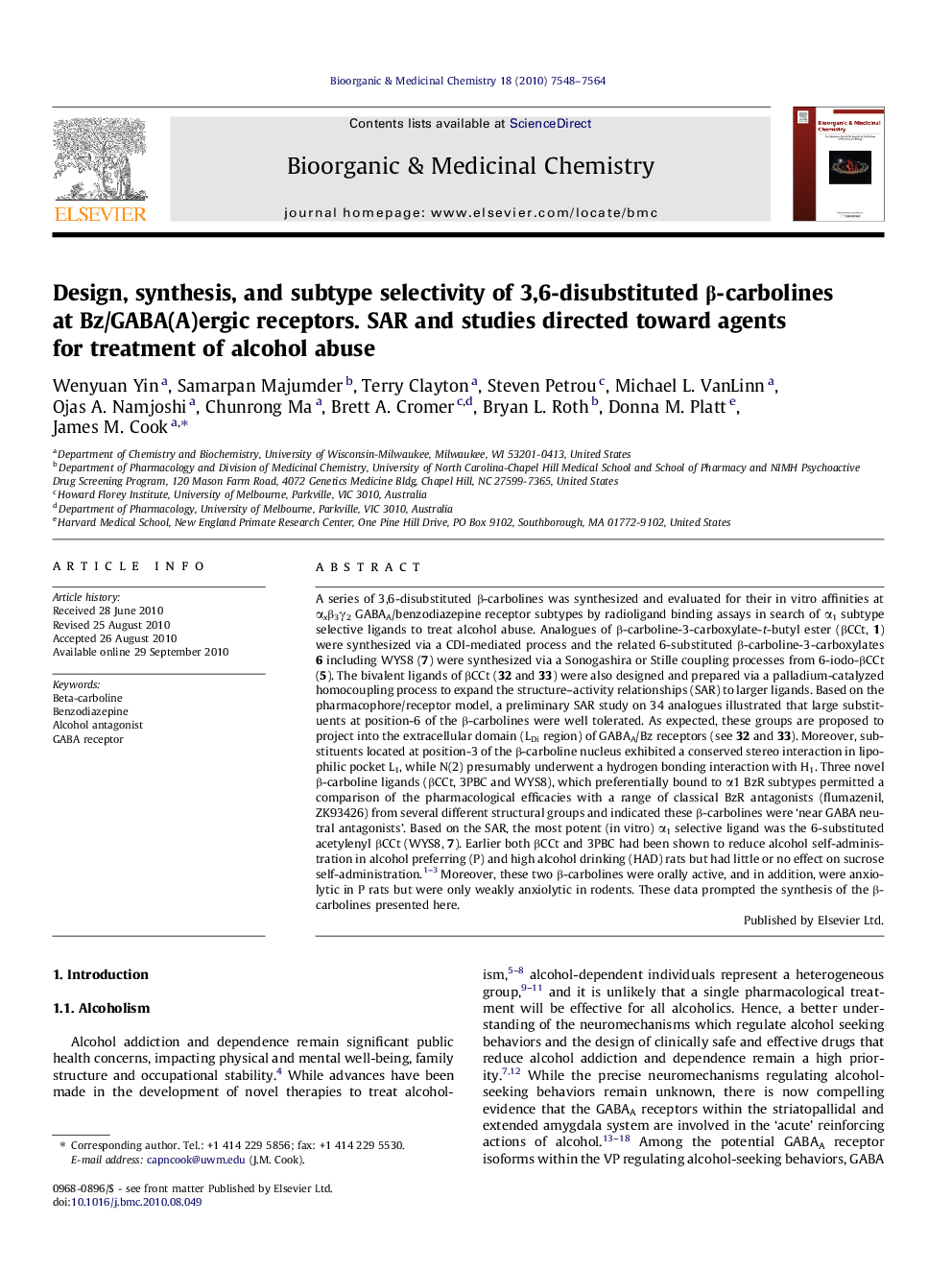| کد مقاله | کد نشریه | سال انتشار | مقاله انگلیسی | نسخه تمام متن |
|---|---|---|---|---|
| 1356286 | 981105 | 2010 | 17 صفحه PDF | دانلود رایگان |

A series of 3,6-disubstituted β-carbolines was synthesized and evaluated for their in vitro affinities at αxβ3γ2 GABAA/benzodiazepine receptor subtypes by radioligand binding assays in search of α1 subtype selective ligands to treat alcohol abuse. Analogues of β-carboline-3-carboxylate-t-butyl ester (βCCt, 1) were synthesized via a CDI-mediated process and the related 6-substituted β-carboline-3-carboxylates 6 including WYS8 (7) were synthesized via a Sonogashira or Stille coupling processes from 6-iodo-βCCt (5). The bivalent ligands of βCCt (32 and 33) were also designed and prepared via a palladium-catalyzed homocoupling process to expand the structure–activity relationships (SAR) to larger ligands. Based on the pharmacophore/receptor model, a preliminary SAR study on 34 analogues illustrated that large substituents at position-6 of the β-carbolines were well tolerated. As expected, these groups are proposed to project into the extracellular domain (LDi region) of GABAA/Bz receptors (see 32 and 33). Moreover, substituents located at position-3 of the β-carboline nucleus exhibited a conserved stereo interaction in lipophilic pocket L1, while N(2) presumably underwent a hydrogen bonding interaction with H1. Three novel β-carboline ligands (βCCt, 3PBC and WYS8), which preferentially bound to α1 BzR subtypes permitted a comparison of the pharmacological efficacies with a range of classical BzR antagonists (flumazenil, ZK93426) from several different structural groups and indicated these β-carbolines were ‘near GABA neutral antagonists’. Based on the SAR, the most potent (in vitro) α1 selective ligand was the 6-substituted acetylenyl βCCt (WYS8, 7). Earlier both βCCt and 3PBC had been shown to reduce alcohol self-administration in alcohol preferring (P) and high alcohol drinking (HAD) rats but had little or no effect on sucrose self-administration. 1, 2 and 3 Moreover, these two β-carbolines were orally active, and in addition, were anxiolytic in P rats but were only weakly anxiolytic in rodents. These data prompted the synthesis of the β-carbolines presented here.
A series of 3,6-disubstituted β-carbolines was synthesized and evaluated for their in vitro affinities at αxβ3γ2 GABAA/benzodiazepine receptor subtypes by radioligand binding assays in search of α1 subtype selective ligands to treat alcohol abuse. Analogues of β-carboline-3-carboxylate-t-butyl ester (βCCt, 1) were synthesized via a CDI-mediated process and the related 6-substituted β-carboline-3-carboxylates 6 including WYS8 (7) were synthesized via a Sonogashira or Stille coupling processes from 6-iodo-βCCt (5). The bivalent ligands of βCCt (32 and 33) were also designed and prepared via a palladium-catalyzed homocoupling process to expand the structure–activity relationships (SAR) to larger ligands. Based on the pharmacophore/receptor model, a preliminary SAR study on 34 analogues illustrated that large substituents at position-6 of the β-carbolines were well tolerated. As expected, these groups are proposed to project into the extracellular domain (LDi region) of GABAA/Bz receptors (see 32 and 33). Moreover, substituents located at position-3 of the β-carboline nucleus exhibited a conserved stereo interaction in lipophilic pocket L1, while N(2) presumably underwent a hydrogen bonding interaction with H1. Three novel β-carboline ligands (βCCt, 3PBC and WYS8), which preferentially bound to α1 BzR subtypes permitted a comparison of the pharmacological efficacies with a range of classical BzR antagonists (flumazenil, ZK93426) from several different structural groups and indicated these β-carbolines were ‘near GABA neutral antagonists’. Based on the SAR, the most potent (in vitro) α1 selective ligand was the 6-substituted acetylenyl βCCt (WYS8, 7). Earlier both βCCt and 3PBC had been shown to reduce alcohol self-administration in alcohol preferring (P) and high alcohol drinking (HAD) rats but had little or no effect on sucrose self-administration. 1, 2 and 3 Moreover, these two β-carbolines were orally active, and in addition, were anxiolytic in P rats but were only weakly anxiolytic in rodents. These data prompted the synthesis of the β-carbolines presented here.Figure optionsDownload as PowerPoint slide
Journal: Bioorganic & Medicinal Chemistry - Volume 18, Issue 21, 1 November 2010, Pages 7548–7564